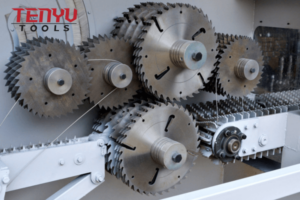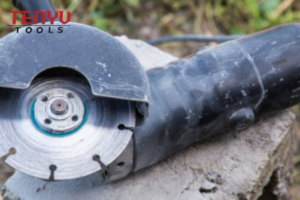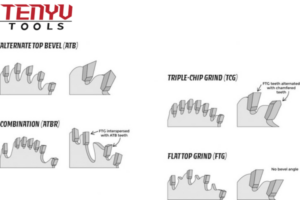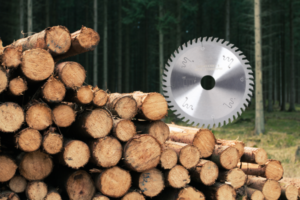Struggling with slow, laborious metal drilling? Wasting valuable time and effort on site? Annular cutters offer a faster, more efficient way to create clean holes in metal.
Yes, for many applications, especially larger diameter holes in steel, annular cutters are significantly better than traditional twist drills. They cut faster, require less force, and produce smoother holes by removing only the material at the periphery.
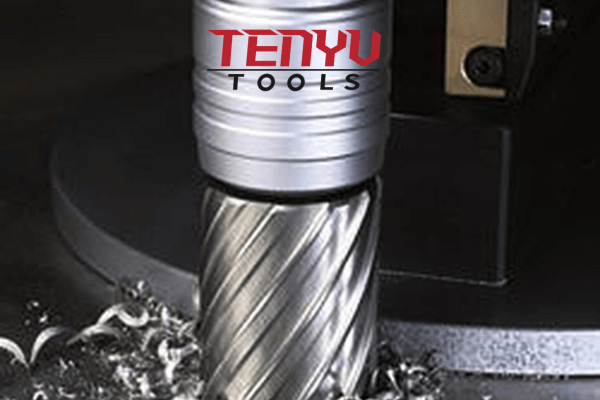
These tools, also known as core drills or hollow drills, have become essential in industries like steel construction and fabrication. But how do they work, what types are there, and are they always the best choice? Let’s dive deeper and find out if they are right for your needs.
What Exactly Is an Annular Cutter?
Confused by terms like "core drill," "hollow drill," or "magnetic drill bit"? Seeing different tools for drilling metal? Let’s clear things up and understand what an annular cutter truly is.
An annular cutter is a specialized drill bit with multiple cutting edges arranged in a circle. Instead of drilling out the entire hole volume like a twist drill, it cuts only a ring (annulus) around the edge, leaving a solid core or "slug."
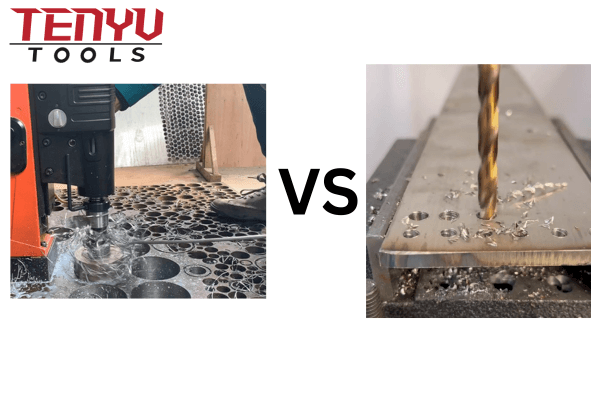
How Annular Cutting Works
The core principle behind an annular cutter is efficiency. Think about drilling a 25mm hole with a standard twist drill. That drill needs to turn the entire 25mm diameter circle of metal into chips. This requires significant power (thrust) and takes time.
Now, picture an annular cutter for the same 25mm hole. It only cuts a thin ring around the outside edge. The center piece of metal, the slug, remains solid and simply falls out (or is ejected by a pilot pin) when the cut is complete. This means:
- Less Material Removal1: You’re only cutting a fraction of the metal compared to a twist drill.
- Lower Power Requirement: Less cutting means less force and torque are needed from the drill motor. This allows for drilling larger holes with smaller, often portable magnetic drills.
- Faster Cutting: With multiple cutting edges (teeth) working simultaneously and less material to remove per tooth, the feed rate can be much higher.
I remember visiting a client’s site where they struggled with drilling large diameter holes in structural beams using large, cumbersome drill presses and twist drills. Switching to portable magnetic drills with our Tenyu annular cutters cut their drilling time by more than half and significantly improved worker safety and flexibility.
Here’s a simple comparison:
| Feature | Annular Cutter | Twist Drill |
|---|---|---|
| Cutting Action | Cuts periphery (annulus) | Cuts entire hole volume |
| Material Removed | Less | More |
| Speed | Faster (often 5-10x) | Slower |
| Power Needed | Lower | Higher |
| Resulting Debris | Slug + fewer chips | Many chips |
| Typical Machine | Magnetic Drill, Drill Press Adapter | Drill Press, Hand Drill (small) |
| Hole Quality | Often smoother, more accurate | Can vary, potential for wander |
Understanding this basic difference highlights why annular cutters are so popular in steel fabrication, shipbuilding, and construction.
What Are the Main Types of Annular Cutters?
Choosing the right tool is vital for performance and cost-effectiveness. Using the wrong type of annular cutter can lead to slow work, damaged tools, or poor results. Let’s look at the primary options available.
The two main types of annular cutters are High-Speed Steel (HSS) and Tungsten Carbide Tipped (TCT). HSS cutters are tough, versatile, and can be resharpened, while TCT cutters offer higher speeds and excel in harder or more challenging materials.
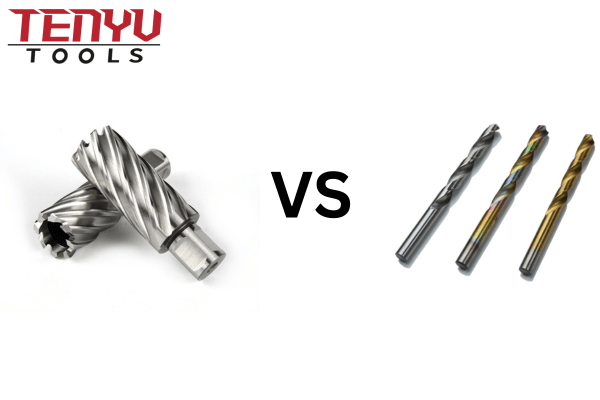
HSS vs. TCT – Making the Right Choice
Selecting between HSS2 and TCT depends heavily on your specific application, the material you’re drilling, the volume of work, and your budget. As a manufacturer at Tenyu, we produce both types to meet diverse customer needs, always focusing on top quality.
High-Speed Steel (HSS) Annular Cutters:
- Material: Made entirely from high-speed steel alloys.
- Characteristics: Known for their toughness and resistance to chipping, especially under less-than-ideal conditions (like slight vibrations or less rigid setups). They offer good performance across a wide range of common steels.
- Key Advantage: They can be resharpened multiple times, extending their life and potentially lowering long-term costs if you have sharpening capabilities.
- Best For: General purpose steel drilling, structural steel, situations where toughness is prioritized, users who prefer resharpening. Our Tenyu HSS cutters are made from premium M2 or M35 (cobalt) steel for enhanced durability.
Tungsten Carbide Tipped (TCT) Annular Cutters:
- Material: The body is typically steel, but the cutting edges (teeth) are brazed-on tips made of extremely hard tungsten carbide.
- Characteristics: Carbide is much harder than HSS, allowing TCT cutters to run at significantly higher speeds and cut through harder materials, including stainless steel, cast iron, and abrasive alloys. They maintain their sharp edge longer under high heat.
- Key Advantage: Faster cutting speeds and longer life in demanding materials, leading to higher productivity.
- Best For: High-volume production, drilling hard or abrasive materials, applications where speed is critical. TCT cutters generally cannot be effectively resharpened. Tenyu TCT cutters use high-grade carbide tips and precision geometry for optimal performance and longevity.
Here’s a table summarizing the key differences:
| Feature | HSS Annular Cutter | TCT Annular Cutter |
|---|---|---|
| Material | High-Speed Steel | Steel Body, Carbide Tips |
| Hardness | Tough, Less Hard | Very Hard, More Brittle |
| Speed | Moderate | High |
| Material Range | Mild & Structural Steel | Steel, Stainless, Cast Iron |
| Lifespan | Good (resharpenable) | Very Good (in hard mat’l) |
| Resharpenable | Yes | Generally No |
| Cost | Lower Initial Cost | Higher Initial Cost |
For buyers like Alex Costa, understanding this trade-off is key. If drilling standard steel structures, high-quality HSS might be cost-effective. If dealing with tougher alloys or needing maximum speed, TCT is likely the better investment. At Tenyu, we help clients like Alex select the optimal cutter type and provide options for custom logos and packaging.
What Makes Annular Cutters So Efficient?
Are you tired of drilling that feels slow and requires excessive force? Need to get jobs done faster, especially on large workpieces or on site? The design of annular cutters inherently boosts efficiency.
Annular cutters are highly efficient because they only remove material from the edge of the hole, requiring less power and thrust. Their multiple cutting edges distribute the workload, allowing for faster feed rates, smoother cuts, and longer tool life compared to twist drills.
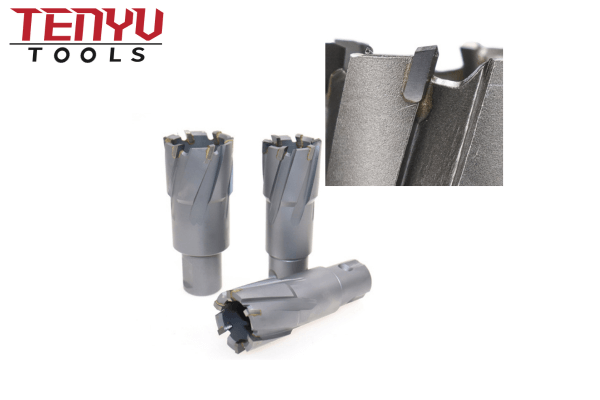
The Efficiency Advantage Explained
Several factors contribute to the remarkable efficiency of annular cutters, making them a preferred choice in many heavy industries. Let’s break them down:
- Reduced Material Removal3: As discussed earlier, cutting only a ring instead of the whole area is the primary efficiency driver. This translates directly into less work for the machine and the tool.
- Multiple Cutting Edges: Unlike a twist drill with only two main cutting edges, an annular cutter typically has anywhere from 4 to 16 or more cutting teeth (depending on diameter). Each tooth takes a smaller chip, reducing the load on individual edges. This allows for:
- Higher Feed Rates: You can push the cutter through the material faster.
- Smoother Cutting: More edges engaged lead to a more stable, less vibrational cut, often resulting in a better hole finish.
- Longer Tool Life: The cutting load is shared, meaning each edge does less work and wears down slower. Our Tenyu cutters feature optimized multi-cut geometry for balanced cutting and extended life.
- Lower Thrust Required: Because less material is being cut and the force is distributed, significantly less downward pressure (thrust) is needed. This enables the use of smaller, lighter magnetic drilling machines, enhancing portability for site work – a huge plus in construction and shipbuilding.
- Internal Coolant: Many annular cutters and magnetic drills are designed for coolant to be delivered through the center of the cutter via a pilot pin. This delivers coolant directly to the cutting edges inside the cut, improving lubrication, heat dissipation, and chip evacuation, further enhancing speed and tool life.
Here’s how these advantages stack up:
| Efficiency Factor | Benefit | Impact for Buyers (like Alex) |
|---|---|---|
| Less Material Cut | Faster drilling, less energy consumed | Reduced labor time, lower energy costs |
| Multiple Edges | Faster feed, smoother hole, longer tool life | Increased productivity, better quality |
| Lower Thrust Needed | Use of smaller/portable magnetic drills | Greater job site flexibility, safety |
| Internal Coolant | Better heat control, improved chip flow | Extended tool life, consistent performance |
For procurement managers focused on cost-efficiency and productivity, these benefits are compelling. The potential to complete drilling tasks 5-10 times faster than with twist drills represents significant savings in labor and project time.
Are There Any Downsides to Using Annular Cutters?
Annular cutters offer impressive advantages, but are they the perfect solution for every drilling task? Knowing their limitations is crucial to avoid misapplication, tool damage, or project delays. Let’s examine the potential drawbacks.
Yes, annular cutters have limitations. They cannot drill blind holes (holes that don’t go all the way through), are difficult to manufacture and use effectively below roughly 12mm diameter, can be challenging on angled surfaces, and require specific chucks or adapters.
Annular Cutters vs. Drill Bits: Speed
When time is critical on a job, the speed difference between annular cutters4 and traditional twist drills is often the deciding factor. Annular cutters are significantly faster, frequently cutting holes 3 to 10 times quicker than twist drills of comparable size in metal. This dramatic speed advantage comes from their fundamental design: they only cut a narrow ring around the hole’s perimeter, removing far less material overall compared to a twist drill, which must pulverize the entire volume of the hole into chips. Recommended cutting speeds reflect this, with annular cutters comfortably operating at 100 Surface Feet per Minute (SFM) or more, while twist drills are often limited to 30-50 SFM (and even less for larger diameters) to prevent overheating and premature wear. This efficiency translates directly into productivity; a task estimated to take 10 days with twist drills might realistically be completed in just 3 days using annular cutters, offering substantial savings in labor costs and helping meet tight deadlines – a crucial point for businesses like Alex Costa’s.
| Speed Aspect | Annular Cutter | Twist Drill (Industrial Drill Bit) |
|---|---|---|
| Relative Speed | Much faster (e.g., 3-10x) | Slower |
| Cutting Action | Removes only periphery material (ring) | Removes entire hole volume as chips |
| Material Removal | Low volume | High volume |
| Typical SFM | 100+ SFM common | 25-50 SFM typical (lower for larger bits) |
| Productivity Impact | High (Significant time savings) | Lower (Longer task duration) |
Annular Cutters vs. Drill Bits: Quality
Beyond speed, the quality of the finished hole is paramount for many applications requiring precision fits or smooth surfaces. Annular cutters consistently produce cleaner, more accurate holes compared to twist drills. Because they cut a ring with multiple precision teeth, the resulting surface finish is smoother, and there’s significantly less burr formation on entry and exit – minimizing the need for secondary deburring operations. The integrated pilot pin plays a crucial role, ensuring the cutter starts exactly on the mark and guiding it throughout the cut, which promotes excellent positional accuracy and perpendicularity. In contrast, twist drills, especially larger ones, can be prone to "walking" when starting the hole if not center-punched properly, and they can sometimes produce slightly oversized or less round holes due to flexing or uneven edge wear. Furthermore, the efficient cutting action of annular cutters generates less heat, which also contributes to better dimensional accuracy and less metallurgical impact on the workpiece material. While twist drills inevitably lose precision as they wear, the wear-resistant nature of annular cutter teeth (especially TCT) helps maintain consistent hole quality over a longer period.
| Quality Aspect | Annular Cutter | Twist Drill (Industrial Drill Bit) |
|---|---|---|
| Hole Finish | Cleaner, smoother | Can be rougher, more imperfections |
| Burr Formation | Minimal | More likely, requires deburring |
| Accuracy/Precision | High (Pilot pin aids guidance) | Lower (Prone to walking, potential oversizing) |
| Perpendicularity | Excellent | Can deviate due to flex |
| Heat Generation | Lower | Higher (Requires effective cooling) |
| Consistency | Maintains accuracy longer (esp. TCT) | Precision decreases with wear (needs sharpening) |
Annular Cutters vs. Drill Bits: Durability & Efficiency
Tool life and overall efficiency directly impact operational costs. Annular cutters are generally considered more durable than standard industrial twist drills, particularly in demanding applications. Their robust, thicker construction is designed for repetitive industrial use. A key factor is how cutting forces are managed: an annular cutter distributes the load across its multiple cutting teeth, allowing for higher feed rates without overloading any single point. Twist drills, however, concentrate immense pressure on their two main cutting edges and the central chisel edge, making them more susceptible to chipping or breaking, especially if pushed too hard or fast. TCT (Tungsten Carbide Tipped) annular cutters, like those we offer at Tenyu, are exceptionally durable due to the extreme hardness and wear resistance of carbide, often lasting for hundreds of holes before replacement is needed. This durability, combined with their faster cutting, contributes to a lower cost per hole. Additionally, annular cutters require less thrust and power from the drilling machine compared to twist drills of the same size. This improved efficiency not only makes them suitable for portable magnetic drills but can also reduce wear and tear on the drilling equipment itself.
| Durability & Efficiency Aspect | Annular Cutter | Twist Drill (Industrial Drill Bit) |
|---|---|---|
| Construction | Heavier-duty, thicker materials | Lighter-duty, thinner materials |
| Load Distribution | Spread across multiple teeth | Concentrated on tip edges |
| Wear Resistance | High (especially TCT), longer life possible | Lower (More susceptible to wear/tear) |
| Failure Mode | Less prone to breakage under normal load | Higher risk of breaking at high speed/feed |
| Lifespan (TCT vs HSS) | TCT very long; HSS good, often resharpenable | HSS standard; requires regular sharpening/replacement |
| Power/Thrust Required | Lower | Higher |
| Machine Wear | Potentially less strain on machine | Potentially more strain on machine |

Understanding the Limitations
While powerful, annular cutters aren’t universally applicable. Being aware of their constraints helps ensure you choose the right tool for the job. At Tenyu, we believe in transparency and helping customers like Alex Costa make informed decisions.
- Cannot Drill Blind Holes: The fundamental design relies on cutting a ring and ejecting a central slug. If the hole doesn’t go completely through the material, there’s nowhere for the slug to go, preventing the cutter from working. For blind holes, twist drills or end mills are necessary.
- Minimum Diameter Limitation: Manufacturing annular cutters with multiple teeth becomes physically challenging and less effective below about 12mm (approx. 1/2 inch). The core becomes too small, and chip evacuation is difficult. For small diameter holes, twist drills remain the standard.
- Difficulty on Angled or Curved Surfaces: Starting a cut on a non-flat surface can be tricky. Only some teeth engage initially, leading to uneven load, potential vibration, and risk of tooth breakage. Special care, slower feed rates, or starting with a pilot hole using a different method might be needed.
- Core Jamming Potential: Occasionally, the slug (core) might get stuck inside the cutter, especially during deep cuts or if chips aren’t evacuating properly. This requires stopping and clearing the cutter. Using proper coolant, feed rates, and sharp cutters minimizes this risk.
- Shank Compatibility: Annular cutters use specific shank types (like Weldon flat, Universal/Nitto, Fein) designed to handle the torque and ensure positive drive, usually in magnetic drills or specialized adapters for drill presses. They generally don’t fit standard Jacobs chucks found on many hand drills or basic drill presses without an adapter.
Here’s a summary of the key considerations:
| Limitation | Description | Workaround / Consideration |
|---|---|---|
| Blind Holes | Cannot drill holes partway through | Use twist drills or end mills |
| Small Diameters | Impractical/unavailable below ~12mm (1/2") | Use twist drills |
| Angled/Curved Surface | Difficult starts, uneven load, potential breakage | Careful feed, pilot hole, specialized technique |
| Core Jamming | Slug can get stuck inside the cutter | Proper coolant, feed rate, sharp tool |
| Shank Requirement | Needs specific shanks (Weldon, etc.), not Jacobs chuck | Use compatible magnetic drill or adapter |
Understanding these points is crucial for procurement. For instance, Alex Costa needs reliable suppliers. A good supplier like Tenyu wouldn’t just sell a cutter; we’d ensure it’s the right cutter for the application, considering these limitations and offering guidance, top-quality tools, and customization options to mitigate challenges.
Conclusion
Annular cutters offer significant speed and efficiency benefits for drilling holes in metal, especially larger diameters in steel. While they have limitations like not drilling blind holes, their advantages often outweigh the drawbacks in construction, fabrication, and manufacturing.
-
Exploring this resource will provide insights into how less material removal can enhance efficiency and reduce waste in machining processes. ↩
-
Explore the benefits of HSS drill bits to understand their applications and why they might be suitable for your needs. ↩
-
Exploring this link will provide insights into how Reduced Material Removal enhances efficiency and reduces costs in manufacturing processes. ↩
-
Explore the benefits of annular cutters, including their speed and efficiency, which can significantly enhance productivity in metalworking. ↩

